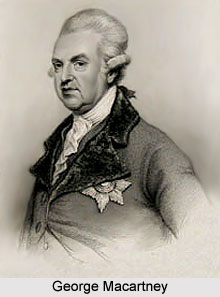 George Macartney, formally known as Sir George Macartney, 1st Earl Macartney, KB, was appointed as the Governor of Madras Presidency from the year 1781 to 1785, in India under the rule of the British Empire. He was a well known statesman, diplomat and Colonial administrator of the British East India Company. Macartney was assigned as the Governor of the Province of Madras (now Chennai) on 22 June 1781. He was preceded by Sir Charles Smith, who served as the acting Governor of the Presidency from 8 November 1780 to 22 June 1781.
George Macartney, formally known as Sir George Macartney, 1st Earl Macartney, KB, was appointed as the Governor of Madras Presidency from the year 1781 to 1785, in India under the rule of the British Empire. He was a well known statesman, diplomat and Colonial administrator of the British East India Company. Macartney was assigned as the Governor of the Province of Madras (now Chennai) on 22 June 1781. He was preceded by Sir Charles Smith, who served as the acting Governor of the Presidency from 8 November 1780 to 22 June 1781.
Early Life of George Macartney
George Macartney was born on 14 May 1737 at Lissanoure in Loughguile, Ballymoney in County Antrim, Ireland. He was born in the Scottish family of the Macartneys of Auchinleck. He successfully completed his graduation from the Trinity College in Dublin in the year 1759. Macartney later studied at the Temple, London (Inns of Court in London), which was the professional associations for barristers in England and Wales. He was later employed under Lord Holland.
Career of George Macartney
He became a Member of Parliament for Armagh Borough in the Irish House of Commons in 1768. After he left office, George Macartney was knighted. In the year 1775, he was appointed as the governor of the British West Indies. In the following year, he became Baron Macartney in the Peerage of Ireland. He held a seat in the British Parliament from the year 1780 to 1781.
George Macartney was made the Governor of Madras Presidency on 22 June 1781. The Madras Presidency, also known as the Presidency of Fort St. George and Madras Province, was an administrative sub division of British dominated India. The territory included most of southern India, such as the modern states of Tamil Nadu, the Coastal Andhra and Rayalaseema regions of Andhra Pradesh, Lakshadweep Islands, the Malabar region of North Kerala, Koraput, Malkangiri, Nabarangapur and Gajapati districts of southern Orissa and the Bellary, Ganjam, Dakshina Kannada, Rayagada and Udupi districts of Karnataka.
During his tenure, the walls of Fort St. George was renovated and fortified. Moreover, several buildings and barracks in the western portion of the Fort were constructed. He also commenced construction on the Hanover square, the Arsenal, the Western Barracks and Palace Street. Macartney took many steps for lighting and naming the streets, registration of deaths and births and the licensing of liquor. He also supervised the formation of a Board of Police, along with a Kotwal.
George Macartney also managed the Treaty of Mangalore that ended the Second Anglo Mysore War in the year 1784. He served in office until 14 June 1785 and was succeeded by Sir Alexander Davidson as the acting Governor of Madras, who served in the position from 14 June 1785 to 6 April 1786. Macartney went back to Britain in the year 1786. Later he was appointed as the Governor of Cape Colony in the year 1797. He served in the designation till 1798.
Personal Life of George Macartney
Sir George Macartney, 1st Earl Macartney, KB was married to Lady Jane Stuart in 1768. She was the daughter of the 3rd Earl of Bute. He died on 31 May 1806 at Chiswick in Middlesex.



















